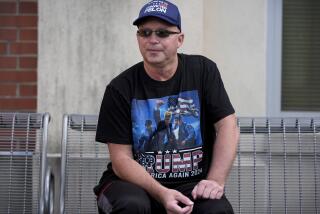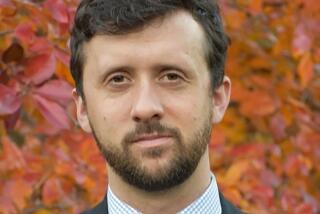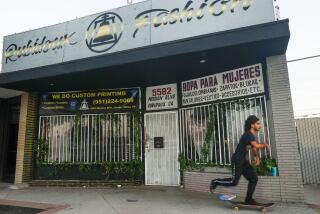DNC Donor’s Offer of Funds to Yeltsin Told
WASHINGTON — A major Democratic Party donor met secretly in 1995 with top aides to Russian President Boris N. Yeltsin and discussed funneling $100 million into Yeltsin’s 1996 presidential campaign in exchange for Russian support of his proposed oil pipeline through Central Asia, according to classified CIA documents, confidential congressional depositions and other sources.
Roger Tamraz, who was also seeking U.S. government support for his pipeline, then informed his contacts at the CIA that he planned to tell President Clinton about his efforts to fund Yeltsin’s campaign, according to the CIA documents.
Some White House officials warned that Clinton should not get close to Tamraz, a fugitive from Lebanese authorities after being charged in a $200-million Beirut bank embezzlement scheme in 1989.
However, then-Democratic National Chairman Donald L. Fowler intervened on Tamraz’s behalf, according to CIA documents. In all, Tamraz contributed $300,000 to state and federal Democratic organizations during the 1996 election campaign.
Tamraz ultimately met six times with Clinton--including four after his clandestine meeting with the Russians--in large receptions and more-intimate gatherings.
But Tamraz said in an interview that he never told Clinton about his Russian initiative. And Special White House Counsel Lanny J. Davis said: “The president doesn’t recall the specifics of any conversation with Mr. Tamraz.”
Tamraz was a central focus Tuesday when the Senate Governmental Affairs Committee called Fowler to testify at hearings on alleged fund-raising abuses during 1996 U.S. election campaigns. Senators questioned Fowler closely about Tamraz’s contributions to the Democratic Party but did not bring up Tamraz’s contacts with the Russians.
Although it could not be determined whether Tamraz ever gave Yeltsin’s campaign any of the $100 million, such a payment could be regarded as a bribe, in violation of the Foreign Corrupt Practices Act, if it was intended as payment for services rendered. The law would apply to Tamraz, since he is a naturalized U.S. citizen.
CIA officers filed a series of reports in late 1995 to the agency’s top officials detailing Tamraz’ plans to fund Yeltsin’s campaign and warning that he had said he would raise the matter with Clinton. Tamraz met secretly with CIA officers in late 1995 to discuss his efforts to win support for his oil pipeline in Moscow and Washington.
The CIA officers also reported that Italian intelligence had confirmed the Tamraz story that he met at the Four Seasons Hotel in Milan, Italy, with Russian Presidential Security Chief Alexander V. Korzhakov and presidential advisor Pavel Borodin, then two of Yeltsin’s closest aides, on Nov. 30 and Dec. 1, 1995. Tamraz told the CIA that he had arranged for a private plane to pick up Korzhakov and Borodin in Moscow and fly them to Milan.
“Korzhakov asked Tamraz to arrange campaign financing of $100 million” in exchange for Yeltsin’s support for Tamraz’s multibillion-dollar project to build a pipeline from the rich oil fields in Azerbaijan’s Caspian Sea basin to Turkey, states a secret CIA “spot report” dated Dec. 12, 1995. “Tamraz said he intended to meet President Clinton . . . to relay results of his meeting with Korzhakov and Borodin.”
Tamraz sought Moscow’s support for his pipeline, which never was built, because of Russian influence in the former Soviet republics through which the pipeline would have been constructed.
In late 1995, the White House national security staff and Vice President Al Gore’s staff warned against giving Tamraz access to top U.S. officials. But according to several internal CIA reports, Fowler sought energetically to get Tamraz into the White House.
Tamraz also managed to get close to Gore even though the vice president’s national security advisor had warned him not to meet with the controversial donor. Working through Democratic Finance Chairman Marvin Rosen, Tamraz joined Gore at the head table during a fund-raiser for Sen. Edward M. Kennedy (D-Mass.) at Kennedy’s home in northern Virginia in October 1995.
The FBI is now investigating Tamraz’s persistent efforts to use both his campaign donations and his CIA connections to win Washington’s support for his oil pipeline plan. The CIA inspector general is also investigating how the CIA managed the Tamraz matter.
Top CIA officials, including Director George J. Tenet, have said their subordinates never informed them about the Tamraz events and that internal CIA reports on Tamraz disappeared before reaching them. Routing sheets for the documents on Tamraz show they were addressed to several top CIA officials or their assistants, but there are no initials on the sheets indicating that the documents were received.
Yet a penciled notation on one of the documents shows that David Cohen, then the CIA’s deputy director of operations, received an “oral brief” on the Tamraz matter in December 1995.
And in early 1996, CIA General Counsel Jeffrey Smith was warned by a White House national security aide that Fowler might have attempted to contact the CIA on behalf of Tamraz. After looking into it, Smith was told by another CIA official that the matter had been “taken care of,” Smith said.
The 57-year-old Tamraz is one of the most colorful characters to emerge from the tangled campaign funding controversy. The son of a self-made Lebanese millionaire and a graduate of Harvard Business School, Tamraz began his business career at Kidder-Peabody in New York in 1967.
As petrodollars began to course through Wall Street, he was quick to take advantage of his Middle Eastern connections. Before long he was enmeshed in a heady mix of international banking, oil and Middle Eastern politics. In 1989 he was kidnapped in Beirut, apparently by a militia leader who lost money when Tamraz’s bank went under.
Along the way, Tamraz developed close ties both to Saudi Arabia’s intelligence service and to the CIA. For a time, he allowed CIA officers under deep cover to pose as employees of his company in Beirut, according to CIA documents.
In the early 1980s, while serving as an advisor to Lebanese President Amin Gemayel, Tamraz caught the eye of the late CIA Director William J. Casey. He was soon acting as an informal back-channel courier between Casey, Gemayel and Israeli Prime Minister Menachem Begin. During the Reagan years, Tamraz also became a major contributor to the GOP.
In 1995, Tamraz resurfaced in Washington in search of support for his new plan for a pipeline that would transport oil from the Caspian basin fields of Azerbaijan through Armenia and Turkey to the Mediterranean.
He persuaded Harry Gilmore, then U.S. ambassador to Armenia, to make some introductions for him in Washington. He also hired an ex-CIA officer, Ed Pechous, to help arrange meetings throughout the bureaucracy.
In May and June of 1995, Tamraz came here for sessions with officials at the State, Energy, and Commerce departments, the Export-Import Bank and the White House National Security Council staff.
At the NSC, Tamraz and Pechous met privately with Sheila Heslin, who was helping coordinate U.S. policy on the Caspian oil basin. On May 17, in preparation for her June 2 meeting with Tamraz, Heslin asked the CIA’s Directorate of Operations for information on Tamraz. CIA officers sent her a file that included derogatory information.
Given the cold shoulder by Heslin and other government officials, Tamraz turned in July 1995 to Fowler to try to gain influence with the Clinton White House. He soon became a major Democratic donor, despite a warning to Fowler in a July 12 memo from his staff that Tamraz “has several problems pending before the international business community.”
Tamraz quickly gained access to the White House and, on Sept. 11, attended his first group meeting with Clinton, a Democratic business leadership reception. He attended White House sessions with President Clinton five more times, the last in June, 1996.
In October 1995, Tamraz’s checkered background led Leon Fuerth, Gore’s national security advisor, to demand that he be kept out of a White House “coffee” with Gore, even though Tamraz already had attended the small Kennedy fund-raising dinner with the vice president on Oct. 2.
Disinvited, Tamraz met with Fowler and other party officials Oct. 6. Tamraz suggested that Fowler contact the CIA and gave him the name and number of his CIA contact in the Directorate of Operations. Fowler’s notes from the meeting mention the CIA and the name of the Tamraz CIA contact.
On Oct. 19, Fowler called Tamraz’s CIA contact, using a so-called “black” phone number given him by Tamraz and used only for clandestine conversations. Fowler asked for help in overcoming the resistance of Gore’s staff to Tamraz’s access to top administration officials.
“It should be noted that at no time did Fowler refer to my CIA affiliation or Tamraz’s previous associations with the CIA,” states an Oct. 20, 1995, CIA memo written by the officer whom Fowler called.
Fowler’s request was rebuffed. During Senate testimony on Tuesday about the matter, Fowler insisted that he did not remember calling the CIA on behalf of Tamraz.
Fowler also tried to persuade Heslin at the NSC staff to lift her opposition to Tamraz but NSC staff director Nancy Soderberg warned Fowler to stop calling Heslin.
In October, Heslin asked the CIA for a second report on Tamraz but the report was not delivered until December. The CIA general counsel’s office first wanted it “sanitized” because the agency is not supposed to distribute derogatory information about American citizens.
In December 1995, Tamraz began meeting again with his CIA contacts and told them that he had “worked out his problems” with the White House, according to an internal CIA report. “Tamraz said he used DNC Chairman Fowler and Mass. Sen. Ted Kennedy to reestablish access to the White House,” the report states.
But Fowler still called the CIA a second time, on Dec. 13, to ask if the agency “could provide a letter on Tamraz to clear Tamraz’s name with the president,” according to an internal CIA report.
Fowler was told by the CIA officer that “such information should be sought at the White House and that we are legally forbidden from discussing any relationship Tamraz may or may not have had with the agency,” according to the CIA internal report.
Tamraz also told his CIA contacts about his plans to fund Yeltsin’s reelection campaign in exchange for support for his pipeline and his plans to raise the matter with Clinton.
“Tamraz said he intended to discuss with the president the Korzhakov meeting, and Korzhakov’s interest in establishing a private channel between Yeltsin and the President using Korzhakov and Tamraz,” said a CIA report dated Dec. 28, 1995. The report also stated that Tamraz said he planned to go to Moscow in January 1996 to follow up on his meetings with Yeltin’s aides.
More to Read
Get the L.A. Times Politics newsletter
Deeply reported insights into legislation, politics and policy from Sacramento, Washington and beyond. In your inbox three times per week.
You may occasionally receive promotional content from the Los Angeles Times.










